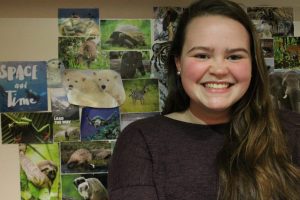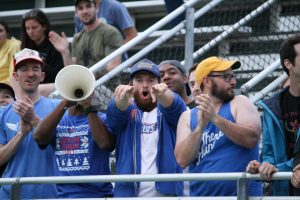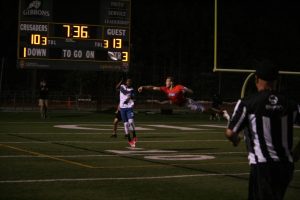By Margaret High
The bow of the Spirit pushed through glassy lake water in the pre-dawn haze. Caeli Harr was on stroke 400 of 1,000 of the morning’s workout. The sun hadn’t risen yet to show her wincing with every repetition. Something was wrong.
She struggled to stand on the dock after finishing her hour-long morning workout. A teammate asked if she was OK.
“I don’t know; something just isn’t right,” Harr said.
Her left hip had been painful for the past month, but the last race in the fall 2017 season for the UNC women’s varsity rowing team was two weeks away. The pain could wait to be addressed. Winning was more important.
The senior scholarship rower knew what was wrong as soon as the pain hit. It was the same injury a fellow recruit from her class suffered from freshman year. A year later, another teammate from her recruiting class also medically retired from the injury. The same fall Harr’s hip hurt, another rower had surgery for the injury and was beginning her eight months of recovery.
Harr tore her left hip labrum sometime in the fall. The labrum is a ring of fibrocartilage. It secures the ball part of the hip’s ball-and-socket joint within the hip socket. It also helps to stabilize the hip joint.
Torn labrums: a common injury, but a relatively new medical discovery
Despite prevalence on the UNC rowing team, torn labrums are a new medical discovery. Roughly 15 years ago, doctors believed the symptoms meant arthritis. Surgery has low success rates, and few orthopedic surgeons know how to do the procedure, which involves reattaching the torn labrum back to the disc within the hip socket. In extreme cases like Harr’s, cadavers are required to replace the shredded labrum.
“The first time I heard it was a torn labrum, tears were just streaming down my face,” Harr said. “I was distraught. I didn’t know what to do.”
In addition to a torn labrum, Harr suffers from a stress fracture in the top of her left femur and a cist within the stress fracture. The daily pain Harr feels from her injuries pushed her to decide to opt for surgery.
Dr. Joseph Barker, a hip specialist in Raleigh, told Harr they would try microfracturing to get rid of the cist. Just like the labrum replacement, it’s a controversial surgery. Microfracturing involves poking holes in the femur to trigger the body’s natural healing responses to a broken bone, increasing blood flow to the area and hopefully healing the stress fracture and cist at the same time.
“I wish I had known how serious it was. I thought it was just another injury,” Harr said. She would’ve stopped sooner had she realized the severity of her issues.
Harr’s history of injuries and passion for sports
Her inevitable surgery will be scar number five on her 5’7” body. Her right knee has two major scars on either side. The left one is from an anterior cruciate ligament (ACL) tear in eighth grade from a non-contact soccer injury. The botched surgery resulted in the right scar.
Harr was a sophomore in high school, just back from three month’s recovery from scar number three that rests beneath her jawline from jaw surgery. It was her third day back at practice. The freckle-faced 15-year-old was running when she tripped and tore her ACL for a second time.
“I didn’t know what to do,” Harr said as she looked down at the ground. “It just tore.”
Soccer was Harr’s passion. It consumed her since first grade. When her parents divorced in middle school, Harr stayed after soccer practice to work on her technique. When only one parent could attend her soccer games instead of both, Harr worked harder to be the best on the field. In between different homes on the weekends, she threw herself into the sport.
“Sports give me a purpose,” Harr said. “When I don’t have structure, I just feel lost. I feel all over the place.”
Discovering rowing
The San Jose, Ca., native needed a sport to satisfy her. Harr’s favorite running trail overlooks a water reservoir, which houses the Los Gatos Rowing Club. Rowing was a sport that could get her into a good university and let her continue to be an athlete without ruining her knee.
“When I first started, I was so bad,” Harr laughed. “I’ve never been so bad at something.”
Her long legs helped propel her body in the boat, but her disproportionately short torso created a litany of technique issues. Six days a week, three hours a day, the Los Gatos head coach, Matt Pinschmidt, berated Harr. The 5’2” former national champion would turn his sharp nose up at Harr, displeased eyes shaded by the baseball caps he always wore.
“I would come home sobbing,” Harr said. “My coach was screaming like bloody murder at me every single day.”
After practice one day, Pinschmidt sat Harr down and told her she should quit. She wasn’t fast enough to be recruited.
Harr worked harder than ever after that day. She shaved off almost a full minute on her 2,000 meter score. She raced every teammate and won. There was no amount of pain Harr couldn’t breach in order to prove Pinschmidt wrong.
“It was really satisfying. I just had this whole ‘screw you’ mentality toward my coach,” Harr said. ”He was absolutely shocked. He had no clue I could actually be that good.”
Soon after, Harr received a scholarship offer for the UNC women’s rowing team.
A year later, Harr was in a four-man boat racing down the Schuylkill River in Philadelphia with more than three seconds between the stern of her boat and the bow of the next. Her Carolina blue unitard swung back and forth quickly in the boat, propelling her to a first-place finish in the largest collegiate regatta in the United States.
She continued to enjoy success as a sophomore, racing in the ACC Championship in the top varsity eight-man boat. Pinschmidt, her former club rowing coach, even sent her a text message before the 2015 ACC Championship, congratulating her success.
“It was like something out of a movie,” Harr said. “We went from hating each other to learning to love each other.”
Hip labral tears are a common injury for UNC’s varsity women’s rowing team
As a junior, one of Harr’s best friends on the team medically retired from a hip labral tear.
Nina Luker, a member of the freshman four-man boat and Harr’s best friend on the team, decided to not undergo surgery after learning of her torn hip labrum. She weighed the options of dealing with the pain or dealing with recovery. Unlike Harr, her labrum doesn’t bother her as intensely every day.
“When I heard it was a labrum tear, I left the doctor in full tears,” Luker said. “You have the idea that something can be kind of a sport-ending injury. But hearing those words come out of someone else’s mouth triggered those emotions. Hearing that I wouldn’t be a student-athlete anymore… that was my identity.”
Alex Davis, another teammate with a torn labrum, felt surgery was her only option.
“I didn’t really have an option,” Davis said. “Basically I needed surgery to resume normal daily activities.”
Davis underwent a six-hour surgery and received a cadaver iliotibial (IT) band to replace her labrum. She was on crutches for three months and has five more months of limited mobility.
Originally, Davis thought she’d just need to have her labrum reattached, the mildest form of surgery for labral tears. However once the surgeon saw her labrum, they found it too damaged to repair. Cadaver was her only option.
“I woke up and thought everything went well,” Davis said. “I was on a lot of drugs, so I think when they told me my recovery would be longer and I’d be on crutches I was a little dazed. But I do remember crying a lot.”
The three rowers, Harr, Davis and Luker, all describe the pain the same: it’s a catching feeling in your hip; it’s always throbbing and constantly commanding attention.
“This whole journey with Caeli is kind of bringing up my memories,” Luker said. “I know the mental struggle that comes with this injury.”
Pushing through their pain resulted in worse injuries for the rowers
All three could’ve avoided shredding their labra had they not continued to push through the pain. It’s their desire to never stop working hard that put them in these positions.
A couple of weeks after the end of her senior fall season, Harr was running up a hill with 47 other teammates on a cold November afternoon. Leaves crunched underneath her feet as sharp pains ran from her hip. Harr began breathing harder with fear that her hip would give out mid-run. The next day she could barely stand.
Harr knew without a doubt her labrum was torn. She had pushed too hard for too long.
Since her initial visit to the doctor in December 2017, Harr has gone through two MRI’s and an arthrogram. The results are all the same: arthritis, stress-fractured femur, bone cist, torn labrum.
Now as the bow of the Spirit cruises through murky lake water, Harr has been replaced. When her teammates wake up, she stays asleep in her bed. The senior lost her last season on the rowing team.
“It really sucks,” Harr said. “Finishing meant I proved everyone wrong.”
Edited by Savannah Morgan



